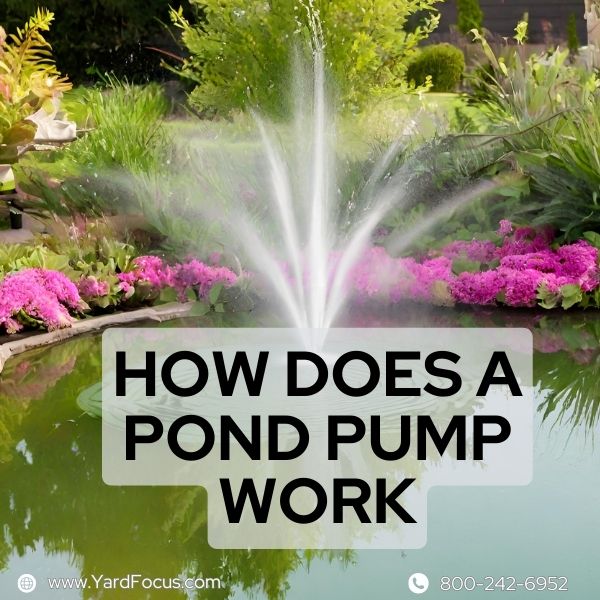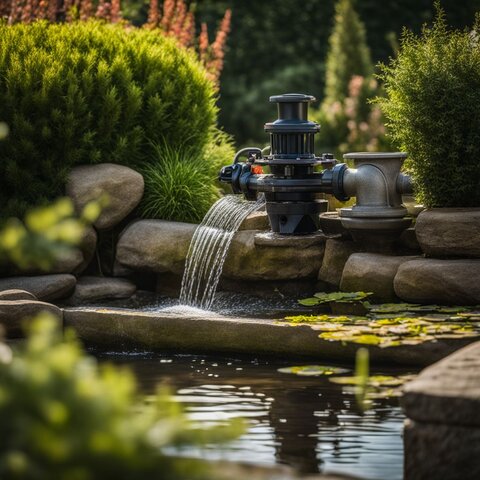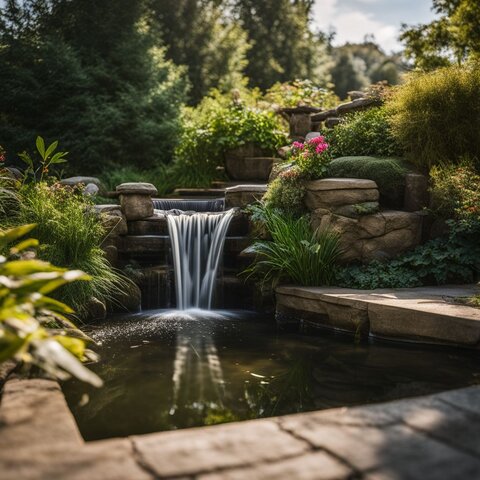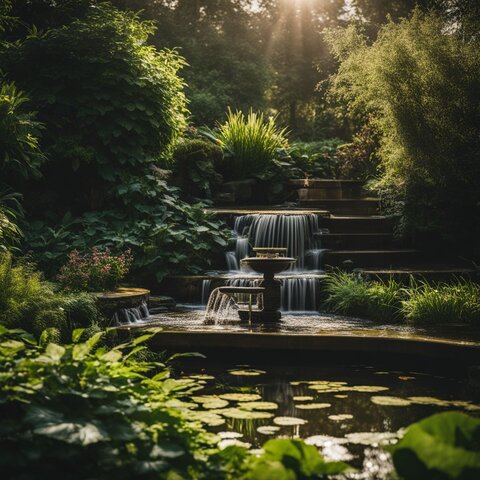
How Does a Pond Pump Work
Many people wonder how does a pond pump work?
This article will dive into how pond pumps work to keep your aquatic paradise thriving, covering everything from types to installation tips.
Keep reading for a splash of knowledge!
Importance of a Pond Pump
A pond pump serves as the heart of your water feature, powering fountains and helping with oxygenation.
This essential piece of equipment ensures a healthy ecosystem for fish and aquatic life by moving water through filtration systems.

Choosing the right pond pump can significantly affect running costs and energy efficiency over time.
Models designed for energy efficiency, including many external pumps, can help reduce electricity costs.
Many pond pump models are designed with replaceable parts, such as motors and impellers, which can save costs compared to purchasing a new unit.
However, availability varies by manufacturer and model.
For ponds with living creatures, having a reliable pond pump is critical to keep the water clean and maintain life.
Having a backup pump can prevent critical situations, such as fish suffocation, in the event of a primary pump failure.
Calculating running costs involves looking at wattage usage against kilowatt-hour rates, which aids in selecting an efficient pump setup for long-term savings.
Next up: exploring the different types of pond pumps available on the market.
Different Types of Pond Pumps
Pond pumps come in various styles, each designed for a specific use.
They help keep water moving and clean, whether it's in a small garden pond or a large koi pond.
Feature Pond Pumps
Feature pond pumps help bring life to water features and pondside ornaments. They are a great choice if you're looking for something budget-friendly.
While these pumps prioritize aesthetics, they also contribute significantly to water circulation.
This circulation is key to preventing stagnant areas in your pond that can harm fish and plants.
These pumps are not designed for heavy lifting like passing large solids to a filter.
Instead, they excel at creating beautiful visuals in your garden or outdoor space.
They work well with eco motors, which can save energy while keeping your water feature running smoothly.
If you have a smaller pond or a specific water feature in mind, feature pond pumps could be the perfect fit.

Fountain Pond Pumps
Fountain pond pumps add beauty to ponds by creating decorative water displays.
These pumps, often submersible, aim for aesthetics rather than filtration, as they cannot move large solids or power waterfalls.
Although fountain pumps are often submersible and may be exposed to more wear, regular maintenance and choosing high-quality models can significantly extend their lifespan.
They excel in providing visual interest but should not be relied upon for significant pond cleaning or circulation tasks.
Next up are filter pumps, crucial for maintaining a healthy aquatic environment.
Filter Pumps
Moving from the aesthetic appeal of fountain pumps, filter pumps come into play as the workhorses in a pond's ecosystem.
These pumps are essential for maintaining healthy water conditions by powering waterfalls or creating a continuous flow within the pond.
Their design ensures efficient water circulation and filtration to maintain healthy pond conditions.
This circulation helps prevent stagnation and keeps the aquatic environment safe for fish and plants.
Filter pumps are designed to handle larger volumes of water and can be combined with UV clarifiers to remove harmful bacteria and algae.
They often serve as the main pump in many ponds, especially those with koi, because they support both mechanical filtration systems and biological processes.
To protect valuable fish life during power outages or equipment failures, having more than one filter pump can be a lifesaver, providing redundancy to keep oxygen levels stable under harsh conditions.

High-Pressure Pond Pumps
High-pressure pond pumps shine in scenarios where you need a lot of water moved to high places quickly.
These pumps are perfect for creating stunning pondless waterfalls or serving as a reliable backup system.
Since they're designed to handle greater head heights, they can push water farther and higher than other types of pumps.
External high-pressure pumps can be more energy-efficient, especially in applications requiring high head heights.
However, energy efficiency varies by specific pump models and usage conditions.
This makes them a top choice for those who want to save on electricity bills without sacrificing performance.
They also tend to have a longer lifespan because they don't sit directly in the water, reducing wear from constant submersion.
Dry Mounted Pond Pumps
Moving from high-pressure pond pumps, we now explore dry mounted pond pumps.
These pumps sit above the water level, outside of the pond. They are known for their efficiency and reliability.
External pumps avoid direct exposure to water, which can mitigate certain operational challenges, such as overheating.
However, modern submersible pumps are also designed to efficiently manage heat through their submerged operation.
Dry mounted pumps are compatible with a range of filter types, including box and koi pond filters, facilitating versatile pond management solutions.
They use pipes to move water from the pond into the pump and back out after filtration.
This setup makes maintenance easier since you don’t have to reach into the water to access the pump.
Plus, they can be more energy-efficient, saving on your kilowatt-hour usage over time.
How a Pond Pump Works
A pond pump acts like the heart of your water garden, pumping water and bringing it to life. It pulls water from the pond through a pipe or hose.
This water movement facilitated by the pump is crucial for oxygenation, as it promotes gas exchange at the water surface, which is vital for the survival of fish and plants.
Submersible pumps sit underwater, quietly working to circulate the water. They push water towards features like fountains or through filters to clean it.
External pumps, which are situated outside the pond, often offer greater energy efficiency than submersible models.
They often come with variable speed controls that help lower electricity use.
By continually moving water, these pumps ensure that your ecosystem pond stays healthy and vibrant while powering stunning waterfalls or supporting koi ponds with necessary oxygen levels.
Considerations When Using a Pond Pump
Choosing the right pond pump is crucial for maintaining a healthy and vibrant pond environment. Here are key factors to keep in mind:
- Determine the size of your pond. The pump you choose needs to handle the volume of water effectively.
- Check the pump's energy efficiency. Sequence pumps, for example, can save on electricity costs as they need to operate around the clock.
- Consider the pump type needed for your pond's requirements. Magnetic drive pumps are ideal for smaller flow rates and lower pressure needs.
- Look at maintenance options. Quality pumps like Sequence allow for parts such as motors and impellers to be replaced, extending their lifespan.
- Be aware of electricity costs per kilowatt hour in your area as this affects running costs of a pond pump.
- Incorporating check valves in your pond pump setup can prevent backflow when the pump is turned off, offering additional protection against potential damage.
- Choose pumps with durable gaskets and seals to avoid leaks that could harm the pump's efficiency and safety.
- If considering an eco-friendly option, explore solar-powered pond pumps which reduce electricity use but depend on sunlight.
Role of Pond Filters in Conjunction with Pond Pumps
Pond filters work with pond pumps to keep water clean and clear. They catch and remove dirt and algae from the water.

All-in-one Internal Pond Filter
All-in-one internal pond filters work hard to keep smaller garden ponds clean and healthy.
They tackle the job by combining mechanical and biological filtration in one compact system.
This makes them a great choice for pond owners who want simplicity without sacrificing performance.
These filters capture debris and use beneficial bacteria to break down harmful waste, much like a car engine uses motor oil to run smoothly.
These systems are especially useful because they can easily be hidden within the pond, maintaining the natural beauty of your garden.
Many also come with ultraviolet clarifiers (UVCS) built in. UVCS kill algae, keeping the water clear.
Installation is straightforward, requiring only minimal pipe fittings and sometimes solar panels for energy-efficient operation.
Pressurised Pond Filter
A pressurised pond filter works wonders for your water garden or koi pond.
It forces water through the filter media under pressure, helping to keep the ecosystem clean and healthy.
This type of filter can handle high volumes of water, making it ideal for ponds with lots of fish or plants.
The best part is that it delivers clean water at pressure, perfect for running waterfalls or other features without losing efficiency.
This system pairs well with UVcs (ultraviolet clarifiers) to ensure your pond stays clear of algae and harmful bacteria.
With a pump pushing water into this sealed unit, waste gets trapped inside while clean, oxygen-rich water flows back out into the pond.
Using a pressurised filter means you're preventing contamination and protecting your aquatic friends from harm.
Box Pond Filter
Box pond filters combine mechanical and biological filtration, making them perfect for smaller garden ponds.
They work by pushing water through a filter media that traps debris and promotes beneficial bacteria growth.
This dual action keeps the water clean and healthy for fish and plants.
Box filters are simple to set up next to your pond and connect to a pump inside the pump house or aquarium.
This kind of filter is one among many available options, including all-in-one internal pond filters, pressurized pond filters, and koi pond filters.
Next, let's dive into how koi pond filters play a pivotal role in maintaining the balance of larger aquatic environments.
Koi Pond Filter
Koi pond filters are crucial for anyone who has Koi fish in their ponds. These special filters handle the extra waste produced by Koi fish.
They help keep the water clean and safe for both the fish and plants living in it.
Healthy pond water is essential, and a good Koi pond filter plays a big part in maintaining it.
Using a high-quality Koi pond filter pumps out waste and stops harmful contamination.
This action protects your aquatic friends and plants from getting sick or dying.
Making sure you have a proper filter system in place supports a thriving ecosystem in your backyard oasis.
FAQs
What does a pond pump do?
A pond pump moves water in the pond to keep it clean and provide oxygen for fish and plants.
How is water pumped in a pond?
The pump pulls water from the pond, pushes it through a filter to clean it, then sends it back into the pond or up through a fountain.
Can I adjust how much water gets pumped?
Yes, most pumps let you change how fast or slow they move the water so you can find what works best for your pond.
Do all ponds need a pump?
Not all, but having a pump helps keep your pond healthy by cleaning the water and making sure there's enough oxygen for everything living in it.
Conclusion
How does a pond pump work to keep water clear and healthy? They move the water helping fish and plants thrive by adding oxygen.
Understand the type of pump your pond needs, from submersible to external ones, for efficiency and longevity.
Remember, investing in a good pump means clearer water, happier living beings in the pond, and lower electricity bills over time.
